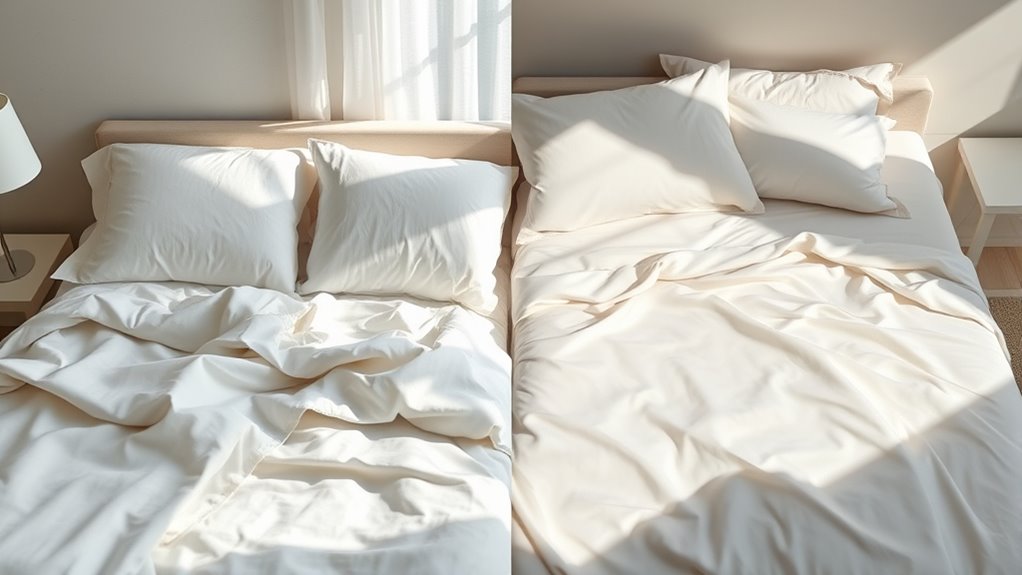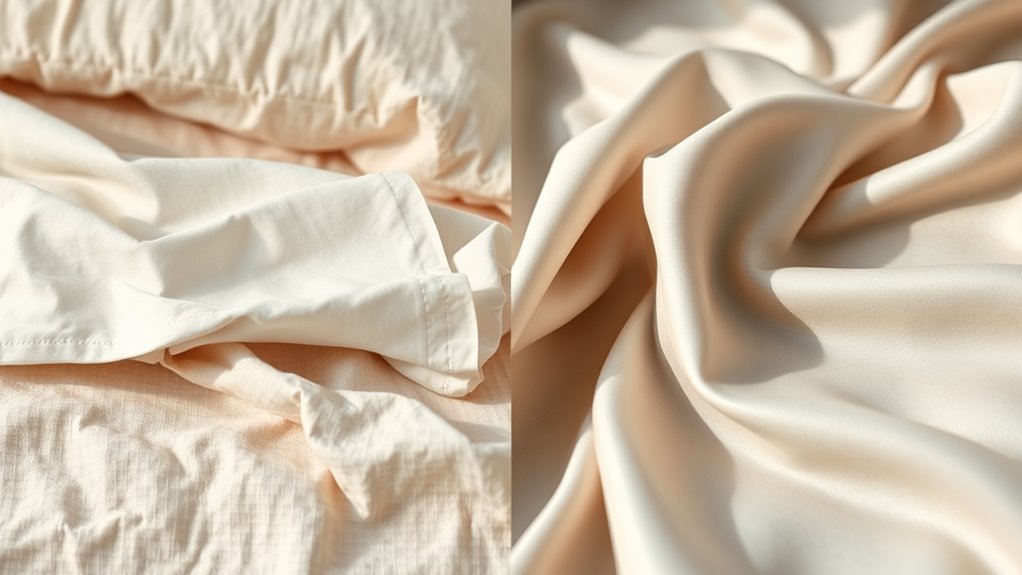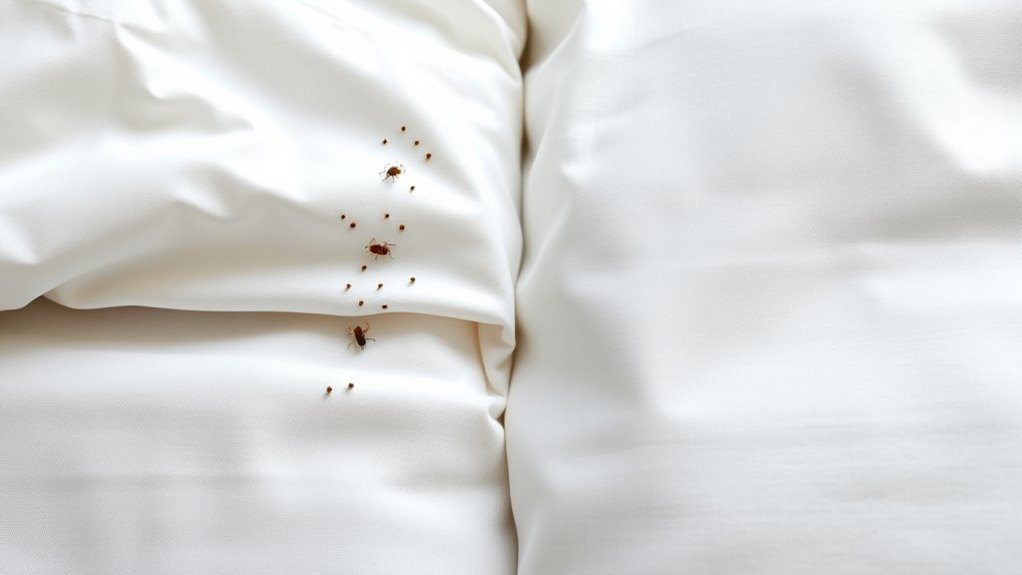Choosing natural bedding like cotton, wool, or linen allows you to enjoy better breathability, temperature regulation, and comfort. These materials are eco-friendly, renewable, and often free from harmful chemicals, making them healthier for your skin and environment. They also tend to be more durable with proper care. If you want to discover how natural fibers can improve your sleep experience while supporting sustainability, there’s more to uncover ahead.
Key Takeaways
- Natural bedding offers superior breathability, moisture management, and temperature regulation for enhanced sleep comfort.
- Eco-friendly and sustainable, natural fibers reduce environmental impact compared to synthetic materials derived from petrochemicals.
- Hypoallergenic and antimicrobial properties of natural bedding minimize allergens, dust mites, and microbial growth.
- While typically more expensive upfront, natural bedding often lasts longer with proper care, providing better long-term value.
- Natural materials contain fewer chemicals and toxins, promoting a safer, healthier sleeping environment.
Breathability and Temperature Regulation

When it comes to breathability and temperature regulation, natural bedding materials generally outperform synthetic ones. Natural fibers like cotton, wool, and linen excel at moisture management, drawing sweat away from your body to keep you dry and comfortable. This enhances airflow, allowing heat to escape and preventing overheating during warm nights. Their porous structure promotes airflow enhancement, which helps regulate temperature naturally. In contrast, synthetic materials often trap heat and moisture, leading to discomfort and disrupted sleep. Natural bedding’s ability to adapt to your body’s temperature ensures a cooler, more comfortable sleep environment. By promoting better moisture management and airflow, natural materials help you stay balanced through varying temperatures, ensuring you wake up refreshed and without feeling too hot or cold. Additionally, ongoing research highlights the importance of AI safety measures in developing safer and more reliable materials for bedding and textiles.
Environmental Impact and Sustainability

You can make a difference by choosing bedding made from eco-friendly materials, which reduce environmental harm. Natural fibers like cotton and wool are renewable resources that grow back quickly, unlike synthetic options derived from petrochemicals. By selecting sustainable options, you support a healthier planet and encourage responsible resource use. Additionally, choosing materials that meet safety standards ensures both environmental and user safety.
Eco-Friendliness of Materials
The eco-friendliness of bedding materials largely depends on their environmental impact and sustainability. Choosing natural options often means supporting sustainable sourcing and eco-conscious manufacturing practices, which reduce waste and energy use. Synthetic materials, however, usually involve chemicals and non-renewable resources, increasing environmental harm. To evaluate eco-friendliness, consider the table below:
| Aspect | Natural Bedding | Synthetic Bedding |
|---|---|---|
| Sustainability | Usually sustainable if sourced responsibly | Often relies on non-renewable resources |
| Manufacturing | Eco-conscious practices common | Typically energy-intensive |
| Environmental Impact | Lower carbon footprint | Higher chemical and waste impact |
Your choice impacts the planet—opt for materials that prioritize sustainability and eco-conscious production to minimize your ecological footprint. For instance, natural fibers like organic cotton or wool are often more sustainable choices due to their renewable nature and lower environmental footprint.
Renewable Resource Use
Using renewable resources for bedding materials considerably enhances their sustainability and reduces environmental impact. When you choose natural options like cotton, wool, or bamboo, you’re supporting sustainable sourcing and raw material renewal. These resources regrow quickly and can be replenished without depleting finite natural reserves. Unlike synthetic fibers, which rely on petroleum and take centuries to break down, natural materials offer a more eco-friendly lifecycle. By prioritizing renewable resources, you help lower carbon emissions and minimize landfill waste. This approach promotes responsible harvesting practices that preserve ecosystems and ensure future availability. Overall, selecting bedding made from renewable resources aligns your choices with environmental stewardship, making your bedding not just comfortable but also a sustainable and conscientious option.
Hypoallergenic and Skin-Friendly Qualities

You want bedding that keeps allergens at bay and feels gentle on your skin. Natural materials often resist common irritants, making them a good choice for sensitive skin. Synthetic options can also be hypoallergenic but may vary in how well they suit your skin type. Additionally, Gold IRA rollovers can be a strategic part of a broader financial plan, emphasizing the importance of diversification and secure investment choices.
Allergen Resistance Factors
Ever wondered what makes certain bedding more resistant to allergens and gentle on your skin? Natural bedding materials often offer better dust mite resistance and mold prevention compared to synthetic options. Natural fibers like organic cotton, linen, and wool have tighter weave structures and inherent antimicrobial properties that reduce allergen buildup. These materials breathe better, preventing moisture accumulation that fosters mold growth. Additionally, they tend to be less likely to trap dust mites, which are common triggers for allergies. Synthetic bedding, on the other hand, can trap heat and moisture, creating a welcoming environment for mold and pests. Choosing natural bedding can help create a healthier sleep environment by inherently resisting common allergens and minimizing mold growth, making it a smart choice for allergy sufferers.
Skin Sensitivity Compatibility
Natural bedding materials are often more compatible with sensitive skin because they contain fewer chemicals and irritants than synthetic options. Their fiber textures are softer and smoother, reducing friction that can cause irritation. Additionally, natural fibers typically avoid harsh dyes, making them less likely to trigger allergic reactions. Synthetic bedding often uses chemical dyes and finishes that can irritate delicate skin. Choosing natural options means you can select dye options that are less processed and more skin-friendly. Here’s a quick comparison:
| Feature | Natural Bedding | Synthetic Bedding |
|---|---|---|
| Fiber Textures | Soft, smooth | Coarser, less breathable |
| Dye Options | Natural, minimal chemicals | Synthetic, chemical-heavy |
| Skin Compatibility | Hypoallergenic, gentle | Potential irritants |
Natural fibers are also biodegradable, making them an environmentally friendly choice for conscious consumers.
Durability and Longevity

Synthetic bedding often outlasts natural options due to its resistance to wear and environmental factors. Its woven strength and material resilience help it withstand frequent use, washing, and exposure to moisture without losing integrity. You’ll find that synthetic fibers maintain their shape and texture over time, making them a durable choice for long-term use. Additionally, synthetic materials are often engineered to resist tuning-related wear, ensuring they stay in good condition even with heavy use. Keep in mind that this durability can come at the expense of breathability and comfort.
Synthetic bedding endures longer, resisting wear but may compromise breathability and comfort.
- Resists shrinking, stretching, and pilling
- Maintains color vibrancy longer
- Less prone to mold or mildew buildup
- Handles frequent washing without damage
- Typically retains structural integrity over years
Care and Maintenance Requirements

Maintaining synthetic bedding is straightforward because it’s designed to withstand regular cleaning routines. To keep it in good condition, follow simple care routines like washing at the recommended temperature and using mild detergents. Synthetic materials typically tolerate machine washing and drying, making cleaning methods easy and convenient. Be sure to check care labels for specific instructions, such as avoiding fabric softeners or bleach that could damage the fabric. Regularly laundering your bedding helps remove dirt, sweat, and allergens, extending its lifespan. Unlike natural materials, synthetic bedding usually requires less delicate handling, which simplifies ongoing maintenance. By sticking to these care routines, you ensure your bedding remains fresh, comfortable, and durable for years to come.
Cost and Affordability

You’ll notice natural bedding often costs more upfront than synthetic options, but it might save you money in the long run. Investing in higher-quality materials can reduce replacement needs and improve durability. Considering these factors helps you weigh the true value of each choice. Additionally, grocery savings strategies can be a useful approach to free up extra funds for purchasing premium bedding options.
Price Differences
Are natural and synthetic bedding considerably different in price? Generally, natural bedding tends to be more expensive upfront due to material variety and higher manufacturing costs. Synthetic options are often more affordable, making them accessible for budget-conscious shoppers. However, cost varies depending on brand reputation and quality. High-end brands, whether natural or synthetic, can command premium prices due to reputation and craftsmanship. You might also find that certain natural fibers like organic cotton or silk are priced higher than standard synthetic blends. Keep in mind that initial cost isn’t the only factor; durability and comfort can influence long-term value. Ultimately, choosing between natural and synthetic bedding depends on your budget, preferences, and how much you value material variety and brand reputation.
Long-term Investment
While natural bedding often costs more upfront, its durability and longevity can make it a smarter long-term investment. Natural materials, like organic cotton or silk, tend to wear better over time, maintaining their luxury appeal longer than synthetic options. This means you won’t need to replace them as frequently, saving you money in the long run. Additionally, investing in reputable brands with strong brand reputation guarantees quality craftsmanship and ethical sourcing, which adds to their lasting value. Though the initial expense might seem high, the durability of natural bedding can offset these costs over years of use. Proper maintenance also plays a crucial role in extending the lifespan of natural bedding materials. Ultimately, choosing natural bedding aligns with a commitment to quality and sustainability, making it a wise choice for those seeking both comfort and long-term savings.
Comfort and Feel

When it comes to comfort and feel, the choice between natural and synthetic bedding plays a significant role in how restful your sleep is. Natural materials often offer superior texture and softness, making you feel more cozy and relaxed. They also tend to provide better temperature regulation, helping you stay comfortable throughout the night. Synthetic options might feel smoother initially but can become less breathable over time, impacting your overall comfort. Natural fibers like cotton and wool mold to your body, enhancing the feeling of luxury. Conversely, some synthetic fabrics can trap heat or moisture, leading to discomfort. Additionally, breathability is a key factor that influences nighttime comfort and sleep quality. Ultimately, your personal preference for feel, warmth, and breathability will guide your choice for better sleep quality.
Chemical Exposure and Toxins

Choosing between natural and synthetic bedding often hinges on concerns about chemical exposure and toxins. Natural bedding materials, like organic cotton or wool, typically offer better chemical safety because they are processed with fewer chemicals and pesticides. Synthetic bedding, on the other hand, can contain chemicals such as formaldehyde, flame retardants, and dyes that may release toxins over time. These substances can impact your health, especially with long-term exposure. By opting for natural options, you can reduce toxin levels in your sleep environment and promote toxin reduction. This choice minimizes your risk of skin irritation or respiratory issues linked to chemical residues. Additionally, necessary cookies can help monitor your preferences and ensure a safer sleep environment. Ultimately, prioritizing natural bedding supports a safer, cleaner sleep space free from harmful chemical exposure.
Resistance to Allergens and Dust Mites

Natural bedding materials often resist allergens and dust mites better than synthetic options because they naturally repel moisture and inhibit microbial growth. This makes them an excellent choice for allergy prevention and dust mite resistance. When dust mites can’t thrive, your allergy symptoms decrease, and your sleep improves. Natural fibers like wool and cotton contain properties that discourage dust mite habitation. They also reduce humidity levels, making environments less hospitable for allergens. To maximize benefits, opt for bedding materials that are breathable and maintain dryness. Proper washing and maintenance further enhance allergen resistance. Choosing natural bedding can markedly lower your exposure to common triggers, promoting better respiratory health and overall comfort. Breathability helps keep bedding dry and less hospitable.
Style and Aesthetic Appeal

Natural bedding not only offers health benefits but also brings a distinctive style and charm to your bedroom decor. With a wide pattern variety, natural fabrics often feature classic, timeless designs that add warmth and personality to your space. Additionally, natural materials come in a rich palette of color options, allowing you to create a calming, cohesive look or a vibrant, lively atmosphere. Their organic textures add depth and visual interest, making your bed a focal point. Whether you prefer a minimalist vibe or a more eclectic style, natural bedding’s pattern variety and color choices help you craft a personalized, inviting bedroom environment. Incorporating cybersecurity considerations into your bedding choices can also protect your personal data and ensure safety in connected smart home environments.
Frequently Asked Questions
Which Bedding Material Is Better for Sensitive Skin?
When choosing bedding for sensitive skin, you should look for materials with hypoallergenic properties that minimize skin irritation. Natural fabrics like organic cotton or silk are often better because they’re breathable and gentle on your skin, reducing irritation. Synthetic materials might trap heat and moisture, increasing discomfort. By selecting bedding with hypoallergenic properties, you can enjoy a more comfortable, irritation-free sleep experience, especially if you have sensitive skin.
How Do Natural and Synthetic Bedding Impact Allergy Symptoms?
Imagine slipping into a bed that feels like a gentle breeze—natural bedding often offers hypoallergenic properties, reducing allergy symptoms and easing your chemical sensitivities. Synthetic materials, on the other hand, can trap dust mites and irritants, worsening allergies. You might notice fewer sneezes and clearer airways with natural fabrics, which breathe better and are less likely to trigger reactions. Choosing natural bedding can help you sleep more comfortably and breathe easier through the night.
Are Synthetic Bedding Materials Fire-Resistant?
Synthetic bedding materials are often designed with fire safety in mind, as many are treated with flame retardant chemicals to reduce fire risk. These treatments help prevent flames from spreading quickly, offering added safety in your home. However, it’s important to check if the bedding is explicitly labeled as fire-resistant or flame retardant, so you can choose options that prioritize your safety without compromising comfort.
Can Synthetic Bedding Be Recycled or Repurposed?
Imagine you’re in a 90s sitcom, and now, you wonder if synthetic bedding can be recycled or repurposed. The good news is, bedding recycling is possible with some types of synthetic bedding, especially those made from recyclable plastics. You can repurpose synthetic bedding into insulation, craft projects, or other household items. Just check the labels and local recycling programs to guarantee proper synthetic bedding repurposing, reducing waste and supporting eco-friendly habits.
How Do Bedding Materials Influence Sleep Quality?
Your sleep environment greatly impacts your sleep quality, and comfortable bedding plays a key role. When you choose the right bedding materials, they help regulate temperature and reduce allergies, leading to better rest. Proper bedding maintenance, like washing regularly and using breathable fabrics, keeps your sleep environment clean and inviting. By selecting quality bedding, you create a cozy space that promotes deeper, more restful sleep every night.
Conclusion
Choosing between natural and synthetic bedding is like picking a partner—you want someone reliable and true to your needs. I once switched to natural linen, and it felt like wrapping myself in a gentle hug every night, breathable and fresh. Remember, your bedding can transform your sleep, just as a good partner can transform your day. So weigh the benefits, trust your instincts, and find the material that makes you feel truly comfortable and at ease.









